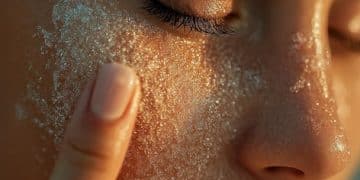Exfoliation Explained: The Ultimate Guide for Fall Skin

Exfoliation is a crucial step in any skincare routine, especially during the fall. It involves removing dead skin cells to reveal smoother, brighter skin beneath, improving skin texture, tone, and overall radiance while optimizing the absorption of skincare products.
As the seasons change, so do your skin’s needs. With fall just around the corner, it’s time to rethink your exfoliation strategy. This guide will help you understand different exfoliation methods and how to choose the best one for your skin type and concerns this fall.
Exfoliation Benefits for Fall Skin
Exfoliation isn’t just a beauty buzzword; it’s a fundamental skincare practice. But what makes it particularly important as we transition into fall? Let’s explore some of the key benefits.
Why Exfoliate in the Fall?
Fall brings cooler temperatures and lower humidity, which can lead to dry and flaky skin. Exfoliation helps combat these issues.
- Removes dead skin cells accumulated during summer.
- Prepares skin for deeper hydration from moisturizers.
- Helps prevent clogged pores and breakouts.
- Improves skin texture and tone, giving you a radiant glow.
Long-Term Skin Health
Regular exfoliation does more than just improve your skin’s appearance. It contributes to its long-term health.
- Boosts collagen production, leading to firmer skin.
- Reduces the appearance of fine lines and wrinkles.
- Improves skin cell turnover, preventing dullness.
- Enhances the effectiveness of other skincare products.

In summary, incorporating exfoliation into your fall skincare routine can address dryness, improve product absorption, and promote long-term skin health, helping you achieve a radiant and youthful complexion.
Understanding Different Types of Exfoliation
Exfoliation isn’t a one-size-fits-all process. There are different methods, each with its own set of pros and cons. Understanding these differences is crucial for choosing the right one for your skin.
Physical Exfoliation
Physical exfoliation involves manually scrubbing the skin to remove dead cells. Here are some common methods:
- Scrubs: Products containing small particles like sugar, salt, or beads.
- Brushes: Facial brushes, such as those used with cleansing devices.
- Sponges: Konjac sponges or textured cloths.
When using physical exfoliants, it’s important to be gentle to avoid irritation. Over-exfoliating can strip the skin of its natural oils, leading to dryness and sensitivity.
Chemical Exfoliation
Chemical exfoliation uses acids or enzymes to dissolve dead skin cells. Common types include:
- AHAs (Alpha Hydroxy Acids): Glycolic acid, lactic acid.
- BHAs (Beta Hydroxy Acids): Salicylic acid.
- Enzymes: Papain, bromelain.
Choosing the Right Type
Consider your skin type and concerns when choosing between physical and chemical exfoliation.
- Oily or Acne-Prone Skin: BHAs are excellent for penetrating pores and dissolving oil and debris.
- Dry or Sensitive Skin: AHAs like lactic acid are gentler and help hydrate the skin.
- Normal Skin: Can tolerate both physical and chemical exfoliation.
Ultimately, understanding the different methods of exfoliation allows you to tailor your skincare routine to meet your skin’s unique needs, resulting in a healthier, more radiant complexion.
Identifying Your Skin Type and Concerns
Knowing your skin type and addressing your specific concerns is essential for an effective exfoliation routine. Incorrect choices can lead to irritation or ineffective results.
Different Skin Types
Here’s a breakdown of the common skin types and their characteristics:
- Oily Skin: Characterized by excess oil production, often leading to enlarged pores and breakouts.
- Dry Skin: Lacks moisture, resulting in flakiness, tightness, and sensitivity.
- Combination Skin: A mix of oily and dry areas, typically with an oily T-zone (forehead, nose, and chin).
- Sensitive Skin: Easily irritated, prone to redness, itching, and allergic reactions.
Common Skin Concerns
Understanding your skin concerns helps you choose the right exfoliation method and ingredients.
- Acne: Requires exfoliation to unclog pores and reduce inflammation.
- Dryness: Needs gentle exfoliation to remove dead skin cells without stripping moisture.
- Aging: Benefits from exfoliation to boost collagen production and reduce fine lines.
- Dullness: Exfoliation helps reveal brighter, more radiant skin.

Patch Testing
Before incorporating a new exfoliant into your routine, perform a patch test.
- Apply a small amount of the product to a discreet area (e.g., inner arm).
- Wait 24-48 hours and monitor for any adverse reactions.
- If no irritation occurs, you can safely use the product on your face.
By identifying your skin type and concerns, along with patch testing, you can make informed decisions about your exfoliation routine, ensuring you achieve the best possible results without causing harm.
Choosing the Right Exfoliation Method for Your Skin Type
Now that you understand the different types of exfoliation and how to identify your skin type, let’s dive into which methods work best for specific skin types.
Oily Skin
Oily skin benefits from regular exfoliation to prevent clogged pores and breakouts.
- BHAs (Salicylic Acid): Penetrate pores to dissolve oil and debris.
- Physical Scrubs: Use with caution, avoiding harsh particles that can irritate.
Dry Skin
Dry skin needs gentle exfoliation to remove dead skin cells without stripping moisture.
- AHAs (Lactic Acid): Hydrate while they exfoliate.
- Enzyme Masks: Provide gentle exfoliation without harsh scrubbing.
Combination Skin
Combination skin requires a balanced approach, addressing both oily and dry areas.
- Multi-Masking: Use different exfoliants on different areas (e.g., BHA on the T-zone, AHA on dry cheeks).
- Gentle Scrubs: Focus on oily areas, avoiding dry patches.
Sensitive Skin
Sensitive skin needs the gentlest exfoliation methods to avoid irritation.
- Enzyme Masks: Provide mild exfoliation without harsh chemicals.
- Konjac Sponges: Gentle physical exfoliation with a soft texture.
Choosing the right exfoliation method for your skin type involves understanding your skin’s unique needs and selecting products and techniques that cater to those needs. With the right approach, you can achieve a healthy, radiant complexion without causing irritation or damage.
Fall-Specific Exfoliation Concerns and Solutions
Fall brings its own set of skincare challenges. Adjusting your exfoliation routine to address these concerns will help maintain healthy, glowing skin throughout the season.
Addressing Dryness and Flakiness
Cooler temperatures and lower humidity can lead to dry and flaky skin. Increase hydration by incorporating moisturizing exfoliants.
- Hydrating Scrubs: Look for scrubs with added moisturizing ingredients like hyaluronic acid or glycerin.
- Lactic Acid: An AHA that exfoliates and hydrates.
Dealing with Dullness
Reduced sun exposure can lead to dullness. Boost radiance with regular exfoliation.
- Glycolic Acid: An AHA that effectively removes dead skin cells.
- Vitamin C Serum: Use post-exfoliation to enhance brightness.
Exfoliating for Sensitive Skin in Fall
Sensitive skin can become even more reactive in the fall. Choose gentle methods and avoid over-exfoliation.
- Enzyme Masks: Provide gentle exfoliation without irritation.
- Limit Frequency: Exfoliate only once or twice a week.
Adjusting Your Routine
As the season changes, reassess your skin’s needs and adjust your exfoliation routine accordingly.
- Monitor Skin: Pay attention to how your skin responds and adjust frequency and products as needed.
- Hydrate: Follow up with a rich moisturizer to lock in hydration.
By understanding these season-specific concerns and solutions, you can adapt your exfoliation routine to maintain healthy, radiant skin throughout the fall months, no matter the weather.
Incorporating Exfoliation into Your Fall Skincare Routine: A Step-by-Step Guide
Now that you’ve chosen the right exfoliation method, here’s how to incorporate it into your daily skincare routine for the fall season.
Step 1: Cleanse Your Skin
Start with a gentle cleanser to remove dirt, oil, and makeup. This prepares your skin for exfoliation.
Step 2: Exfoliate
Apply your chosen exfoliant according to the product instructions.
- Physical Exfoliants: Gently massage onto the skin in circular motions for 1-2 minutes.
- Chemical Exfoliants: Apply evenly and leave on for the recommended time.
Step 3: Rinse Thoroughly
Rinse your skin thoroughly with lukewarm water to remove any residual exfoliant.
Step 4: Apply Serum
After exfoliation, your skin is more receptive to serums. Apply a hydrating or antioxidant serum.
Step 5: Moisturize
Lock in hydration with a rich moisturizer. This is especially important in the fall to combat dryness.
Step 6: Protect with Sunscreen
Even in the fall, sunscreen is essential. Apply a broad-spectrum sunscreen with an SPF of 30 or higher.
By following this step-by-step guide, you can seamlessly integrate exfoliation into your fall skincare routine, ensuring your skin stays healthy, hydrated, and radiant throughout the season.
| Key Point | Brief Description |
|---|---|
| 🍂 Fall Exfoliation | Combat dryness and dullness with proper exfoliation techniques during the fall season. |
| 💡 Physical vs. Chemical | Choose between physical (scrubs, brushes) and chemical (AHAs, BHAs) exfoliation based on your skin type. |
| 🔍 Skin Type Matters | Oily, dry, combination, and sensitive skin types require different exfoliation approaches for best results. |
| 🗓️ Routine Steps | Integrate exfoliation into your routine by cleansing, exfoliating, rinsing, applying serum, moisturizing, and protecting with sunscreen. |
Frequently Asked Questions
Exfoliation is the process of removing dead skin cells from the surface of your skin. It’s important because it reveals brighter, smoother skin, prevents clogged pores, and improves the absorption of skincare products.
The frequency depends on your skin type and the exfoliation method. Generally, exfoliating 1-3 times per week is recommended. Adjust as needed based on how your skin feels.
Yes, but choose gentle methods like enzyme masks or konjac sponges. Avoid harsh scrubs or strong chemical exfoliants. Always patch test new products before applying them to your entire face.
BHAs (like salicylic acid) are excellent for oily skin. They penetrate pores to dissolve oil and debris. Physical scrubs can also be used, but be gentle to avoid irritation.
Yes, moisturizing after exfoliating is crucial. Exfoliation can sometimes dry out the skin, so applying a rich moisturizer helps to lock in hydration and keep your skin healthy and balanced.
Conclusion
Choosing the right exfoliation method for your skin type and concerns is crucial for a healthy and radiant complexion, especially during the fall season. By understanding the different types of exfoliation, identifying your skin’s needs, and adjusting your routine as necessary, you can achieve the best possible results and maintain beautiful skin throughout the year.





